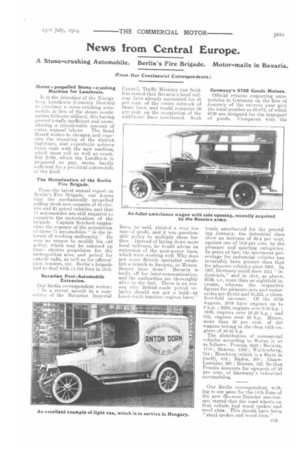News from Central Europe.
Page 15

If you've noticed an error in this article please click here to report it so we can fix it.
A Stone-crushing Automobile. Berlin's Fire Brigade. Motor-mails in Bavaria:
(From Our Continental Correspondents.) Motor propelled Stone .ciushing Machine for Landkreis.
It. is the intention of the Konigsberg Landkseis (Country District)
putchase a stone-crushing automobile in lieu of the steam oombination hitherto utilized, this having proved totally inefficient and necessitating a. considerable amount of extra manual labour. The Road Board wishes to cheapen and expedite the repairing of the district highways, and expectsAn achieve these ends with the new machine, which must roll as well as crush. But X400, which the Landkreis prepared to pay, seems hardly sufficient for a practical automobile of the kind.
The Motorization of the Berlin Fire Brigade.
From the latest annual report on Berlin's Fire Brigade, one learns that the mechanically propelled rolling stock now consists of 49 electric: and 25 petrol vehicles, and that 71 automobiles are still required to complete the motorization of the brigade. Captain Reichert emphasizes the urgency of the acquisition of these 71 automobiles " in the interest of working uniformity." He sees no reason to modify his old policy, which may be summed up thus : electric propulsion for the. metropolitan area, and petrol for outside calls, as well as for officers' ears. tenders, etc. Berlin's brigade had to deal with 14,854 fires in 1913_ Bavarian Post-Automobile Extension.
Our Berlin correspondent writes : " To a recent speech in a committee of the Bavarian Imperial Council, Traffic Minister von Scidkin stated that Bavaria's local railway lines already accounted for 45 per cent. of the entire network of State lines, and would comprise 50 per cent. on the completion of the additional lines sanctioned. Such
he said, yielded a very low rate of profit, and it was questionable policy to multiply them further. Instead of laying down more local railways, he would advise an extension of the post-motor lines, -which were working well. Why does not some British specialist establish a branch in Bavaria, as Messrs. Saurer have done? Bavaria is badly off for inter-communication, and the authorities are thoroughly alive to the fact. There is no reason why British-made petrol vehicles should not get a hold—as Leeds-built traction engines have."
Germany's 9739 Goods Motors. Official returns respecting automobiles in Germany on the first of January of the current year give the total number as 93,072, of which 9739 are designed for the transport of goods. Compared with the.
totals ascertained for the preceding January, the industrial class show an increase of 26.4 per cent. against one of 18,9 per cent, by the pleasure and sporting .eategories. In point of fact, the increment percentage for industrial vehicles has invariably been greater than that for pleasure vehicles since 1908. In 1907, Germany could show 1211 " industrials," and in 1914, as above, 9739, i.e., more than an eightfold increase, whereas the respective figures for pleasure ears and motorcycles arc 25,815 and 83,333, a threefour-fold increase. Of the 9739 wagons, 2019 have engines up to 8 h.p. ; 2259, engines over 8-10 h.p. ; 4619, engines over 16-40 h.p. ; and 812, engines over 40 h.p. Hence, more than 50 per cent,, of the wagons belong to the class with en. gines of 16-40 h.p.
The distribution of commercial vehicles according to States is as as follows: Prussia, 4916 ; Bavaria, 1718; Saxony, 1365; Wurtemberg, .544; Hamburg (which is a State in itself), 412 ; Baden, 368 ; AlsaceLorraine, 291 ; Hessen, 125. So that Prussia accounts for upwards of 50 per cent. of Germany's industrial automobiles,
Our Berlin correspondent, writing in our issue for the 18th June of the new German-Daimler one-tonner, stated that the road wheels on that vehicle had wood spokes and steel rims. This should have been " steel spokes and wood rims."


























